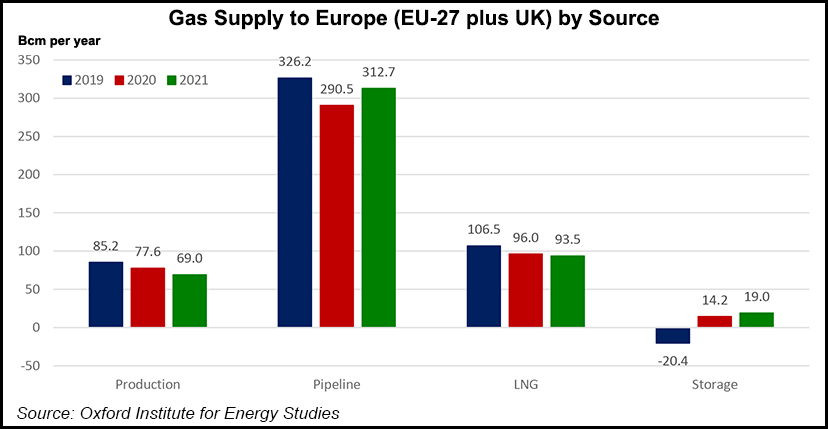LNG | LNG Insight | NGI All News Access | NGI The Weekly Gas Market Report
Europe’s Plan to Cut Russian Natural Gas Imports Said ‘Highly Ambitious’ in Tight Global Market
Europe’s plan to cut its dependence on Russian natural gas and find new sources to displace its largest supplier is seen facing significant obstacles.

The European Commission (EC) announced a plan this week to reduce demand for Russian natural gas by two-thirds by the end of this year and gain independence by 2030. The proposal calls for increasing liquefied natural gas (LNG) imports by 50 billion cubic meters (Bcm) in 2022. Energy analysts said it is a lofty goal given the tight market even before Russia invaded Ukraine and shocked global energy supplies.
“It’s going to be an uphill battle,” Rystad Energy analyst Kaushal Ramesh told NGI. “There isn’t an extra 50 Bcm of LNG production this year without a demand reduction somewhere else.”
Can Europe Reduce Russian Natural Gas Imports?
Some gas supplies could be squeezed from Asia, which has room to switch to coal and oil as buyers in the region may want to avoid high spot prices, Ramesh added. Eventually, the continent would also have to outbid Asian buyers more aggressively for additional spot cargoes.
“Europe will likely take the majority of the incremental volumes out of the Atlantic Basin,” he said. “That would be mainly the U.S., Trinidad and Tobago, and West Africa.”
With most global LNG supply tied into long-term contracts, “it’s unclear where this LNG is coming from,” said energy geopolitics expert Marco Giuli of the Brussels School of Governance in Belgium.
Global capacity is maxed out, he told NGI. This year “we will only see about 12 Bcm of additional liquefaction capacity coming onstream.” He said those supplies would mainly come from the United States and Indonesia, along with the possibility of about 4.5 Bcm from Norway if the Hammerfest LNG facility is returned to service.
The EC’s long-term plans are to gradually phase out at least 155 bcm of natural gas by 2030, or the equivalent of what it imported from Russia in 2021. By the end of 2022, the EC is looking to replace 100 Bcm of Russian gas imports.
Jefferies LLC energy analysts said the EC’s 50 Bcm LNG target is “highly ambitious,” but a reduction of 65 Bcm for Russian gas imports this year could be achievable.
“This can be delivered through a mix of higher production, alternative import sources, lower gas power generation, and enhanced energy savings,” Jefferies analysts said in a research note on Wednesday.
The global energy watchdog, the International Energy Agency, and the Oxford Energy Institute for Energy Studies (OIES) also estimated that the potential reduction in Europe’s Russian gas imports is lower than that estimated by the EC.
Barclays analysts also noted that, while Europe has considerable regasification capacity for LNG intake, the facilities are not operating at full utilization.
Ramesh said Western Europe terminals would need to be at 100% utilization throughout the year. “This will be a feat considering they operate at less than 50% in a typical year.”
Utilization rates ran at around 45% in 2021, according to Barclays analysts. However, January utilization rates increased to 80%, as high European gas prices attracted more cargoes and vessels were diverted from Asia.
Additional European LNG imports would also be hampered throughout the year by a potential lack of storage facilities to take up summer volumes, Barclays analysts added. The largest regasification facilities are in France, Italy, Spain, Turkey and the UK.
Pipelines And Storage
Replacing 10 Bcm of Russian gas by increasing pipeline imports may be feasible. Since the beginning of the year, the European Union (EU) has been in discussions with Algeria, Azerbaijan, Egypt, Israel, Japan, Korea, Nigeria, Norway, Qatar, Turkey and the United States for additional LNG or pipeline imports.
The EC’s proposal also includes a requirement that storage facilities be filled to 90% of capacity by October each year.
“Current storage levels are at 30%, therefore any such plan would require significant additional imports from alternative sources in the intervening period,” Barclays analysts said.
OIES earlier this week said refilling European storage inventories, which are below the five-year average, would be “severely compromised” without Russian volumes.
Replacing 20 Bcm of gas with new wind and solar additions is also seen as a challenge, according to Jefferies analysts. The EC’s proposal to deploy more capacity does not include commitments beyond what has already been targeted in legislative proposals to help the continent achieve climate neutrality.
“The EU document is an aspirational one, meaning we won’t have an imposition of targets,” Giuli said. “The Commission has just outlined a possible pathway for the reduction of reliance on Russia.”
© 2024 Natural Gas Intelligence. All rights reserved.
ISSN © 1532-1231 | ISSN © 2577-9877 | ISSN © 1532-1266 |


